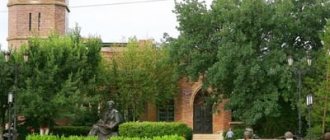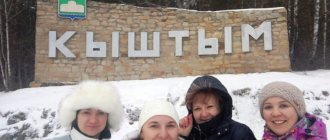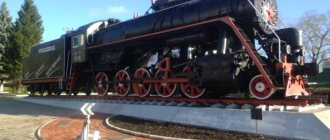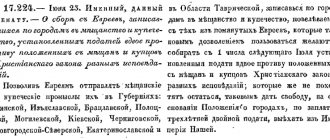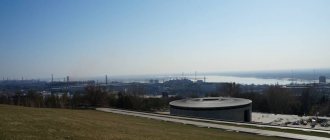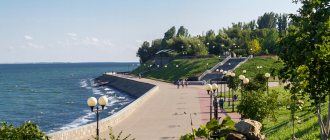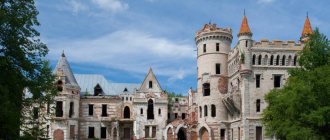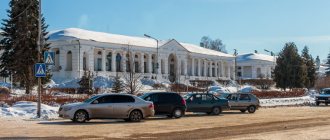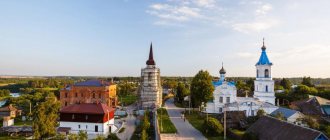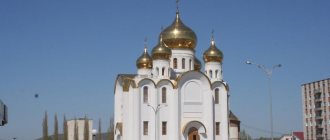| City Desnogorsk Flag |
| A country | Russia, Russia |
| Subject of the federation | Smolensk regionSmolensk region |
| Urban district | Municipal entity "City of Desnogorsk" |
| Coordinates | 54°09′11″ n. w. 33°17′25″ E. d. / 54.1530861° s. w. 33.2902917° E. d./54.1530861; 33.2902917 (G) [www.openstreetmap.org/?mlat=54.1530861&mlon=33.2902917&zoom=12 (O)] (Z)Coordinates: 54°09′11″ N. w. 33°17′25″ E. d. / 54.1530861° s. w. 33.2902917° E. d./54.1530861; 33.2902917 (G) [www.openstreetmap.org/?mlat=54.1530861&mlon=33.2902917&zoom=12 (O)] (I) |
| Internal division | 10 microdistricts |
| Head of the municipality | Sedunkov Vyacheslav Vladimirovich |
| Based | in 1974 |
| City with | 1989 |
| Square | 43 km² |
| Center height | 200 |
| Population | ↘28,293[1] people (2016) |
| Density | 657.98 people/km² |
| Names of residents | desnogortsy, desnogortsy |
| Timezone | UTC+3 |
| Telephone code | +7 48153 |
| Postal codes | 216400, 216401 |
| Vehicle code | 67 |
| OKATO code | [classif.spb.ru/classificators/view/okt.php?st=A&kr=1&kod=66410 66 410] |
| Official site | [desnogorsk.admin-smolensk.ru/ rsk.admin-smolensk.ru] |
| Desnogorsk Moscow |
| Smolensk Desnogorsk |
K: Settlements founded in 1974
Desnogorsk
- city (1989) of regional subordination of the Smolensk region of Russia. Administrative center of the municipal formation "City of Desnogorsk".
Story
In 1966, the Council of Ministers of the USSR adopted Resolution No. 800/252 “On the construction of a nuclear power plant in the Smolensk region.” By order of the Minister of Energy and Electrification of the USSR dated December 1, 1971 No. 311, construction of auxiliary life-supporting facilities began at the industrial site of the future nuclear power plant: a railway, a start-up boiler house, a temporary construction camp, and a house-building plant.
In July 1972, the first cubic meters of concrete were laid for the houses of the future city.
In 1973, the construction of the Smolensk Nuclear Power Plant was declared an All-Union Komsomol construction project.
On February 26, 1974, the Smolensk Regional Executive Committee of Workers’ Deputies adopted decision No. 118 “On registering a newly emerged settlement during the construction of the Smolensk Nuclear Power Plant on the territory of the Roslavl region and classifying it as a workers’ settlement.” Since that time, the village of Desnogorsk has officially appeared on the map of Russia.
Together with the village, SAES power units were built and put into operation. In December 1982, the first power unit with a capacity of 1 million kW/hour was launched, in May 1985, the second power unit, and in January 1990, the construction of the third power unit was completed.
On October 31, 1989, by the Decree of the Presidium of the Supreme Soviet of the USSR, the working village of Desnogorsk was classified as a city of regional subordination[2].
Bases and campsites on the Desnogorsk reservoir
There are many different recreation centers located on the Desnogorsk Reservoir. In addition to cozy houses, there is all the infrastructure necessary for a comfortable stay. You can also stay at campsites - specially designated areas for tent cities, where there are toilets and showers.
Tourist base "Beresta"
The recreation center is located in the village of Bogdanovo. Here you can stay in both houses and tents. On the territory there is a bathhouse, a cafe, gazebos, a shooting range and a children's playground. Detailed information about recreational conditions can be found on the official website of the Beresta tourist center.
Camping “Cool Place”
In the village of Bogdanovo, on the shore of the reservoir, there is the “Cool Place” camping site, which offers guests cozy gazebos with a capacity of 6 to 20 people, equipped with electricity. There is a beach with piers and a volleyball court. Vacationers are provided with places where they can put up tents and caravans. Detailed information about the services is available on the official website of the Cool Place camping site.
Cabins in the “Cool Place”, © Camping page “Cool Place” VKontakte
"Bogdanovo"
In the village of Bogdanovo there is a recreation center of the same name. Excellent conditions have been created here for a secluded, relaxing holiday, and for noisy companies. Guests are offered gazebos with barbecues, sun loungers on the beach, pontoons for fishing, rental of jet skis and motor boats. This base especially attracts lovers of underwater hunting, who are provided with all the necessary equipment. Detailed information about services and living conditions is presented on the official website of the Bogdanovo base.
"Dubrava"
Guest house "Dubrava", located near the village of Bogdanovo, offers vacationers comfortable rooms with separate entrances and all amenities. On the territory of the base there is a banquet hall and a summer veranda, from where picturesque landscapes open up. Guests can order meals; for those who prefer to cook themselves, there is a kitchen. You can book a room on the official website of the Dubrava guest house.
Houses of the Kovcheg base, © marjashkakobzeva
"The ark"
The recreation center offers rooms for 3 and 4 people, which include a lounge and a kitchen. You can live in them at any time of the year, as they are heated. Guests have access to a sauna and secure parking. You can also rent fishing equipment and buy bait here. Detailed information can be found on the official website of the Kovcheg recreation center.
"Space"
You can stay at the Cosmos recreation center at any time of the year; they offer a wide range of services for both summer and winter recreation - picnic areas, rental of skis, snowmobiles, and boats. The area is well-groomed and clean, there is a parking lot. The base is located 2 km from the village of Bogdanovo. More information about the Cosmos recreation center can be found on its official website.
© Vitaly L.
Other bases
There are many more recreation centers on the Desnogorsk Reservoir that offer guests comfortable conditions. Particularly popular among them are “Prichal”, “Green Grove”, “Sandy Beach”, “Silver Key”, “Chistye Rosy”, “Lighthouse”. Vacationers are provided with fishing equipment and watercraft for rent.
Economy
| This section is excessively long or contains unimportant details. If you do not agree with this, please show in the text the materiality of the material presented. Otherwise, the section may be deleted. Details may be on the talk page. |
- Smolensk NPP.
- Enterprise "Polymer". One of the largest manufacturers of polymer packaging in Russia.
- Smolensk educational and training center (DPZ LLC)
- MUP "Combine of Municipal Enterprises"
- JSC "ElS"
- Smolensk Department - branch of JSC "Electrocentromontazh"
- Branch of JSC "E4-Tsentrenergomontazh" Desnogorsk installation department (ceased to exist: liquidation
- Branch "Smolenskenergozaschita" OJSC "
- JSC "NP "Avtotrans"
- JSC "AESP"
- LLC "Smolensk NPP - Service"
- "Smolenskatomenergoremont" is a branch of JSC "Atomenergoremont".
- "Smolenskatomtekhenergo" - a branch of JSC "Atomtekhenergo"
How to get there
Guests of the region can first get to Smolensk in any convenient way - by train, plane or bus. The distance from Smolensk to the Desnogorsk reservoir is 150 km. There is no direct regular transport connection between them, so you will have to travel by car.
From Smolensk
If you leave Smolensk, you should head along the Roslavl highway, after 100 km get onto the A-130 highway. Drive along it for 4.7 km and turn left onto 66K-16 or Warsaw Highway, depending on where you plan to stop.
Route by car from Smolensk to the Desnogorsk reservoir
From Bryansk
The distance from Bryansk to the Desnogorsk reservoir is 180 km. Leaving the city, take the P-120 highway to Roslavl. Then turn onto highway A-130, after 5 km - onto 66K-16. The reservoir will be just outside the village of Bogdanovo.
From Moscow
From the capital you need to leave through the Moscow Ring Road onto M-1, after 73 km turn onto A-108. Follow it for 11 km and turn onto 46Н-05986. Then you need to get onto the Warsaw Highway and follow it towards Desnogorsk.
Education
| This section is excessively long or contains unimportant details. If you do not agree with this, please show in the text the materiality of the material presented. Otherwise, the section may be deleted. Details may be on the talk page. |
Preschool educational institutions
- Kindergarten "Alenka"
- Kindergarten "Thumbelina"
- Kindergarten "Swallow"
- Kindergarten "Forest Fairy Tale"
- Kindergarten "Mishutka"
- Kindergarten "Teremok"
- Kindergarten "Cheburashka"
- Kindergarten "Ivushka"
Schools
- School № 1
- School number 2
- School No. 3
- School No. 4
- "Education Center"
- Desnogorsk Energy College
Other
- Children's art school
- Children's music school
Fishing
You can fish on the Desnogorsk Reservoir all year round, except for the period of the spawning ban, the timing of which depends on the weather and is constantly changing. The bite is good in any season, so even novice fishermen do not leave empty-handed.
Bite forecast on the Desnogorsk Reservoir
To make a rich catch, you need to fish from a boat. The bottom of the coastline is textured, and there is a high risk that the fish will fall off the hook. Crayfish are well caught near the shore. Recreation centers provide detailed information about the best fishing spots.
© Mikhail Vladimirovich K.
The Desnogorsk Reservoir is home to roach, pike, perch, bream and pike perch. Also caught here are grass carp, Mozambican and channel catfish, silver carp, and African tilapia. The reservoir is rich in crayfish and freshwater shrimp.
Fishing reports 2022 on the Rusfishing forum
In summer, the most fishermen gather at the Desnogorsk Reservoir. To catch fish at this time, you can use almost any gear - different types of fishing rods, spinning rods. Corn, bread, worms and bloodworms are ideal baits; to catch grass carp, you need to use dill.
Dam on the Desnogorsk reservoir, © Egor Nazarov
Not everything in the Desnogorsk Reservoir freezes in winter; ice fishing is possible in places far from the nuclear power plant. Bottom fishing rods are suitable for fishing in winter. It is better to use pieces of fish meat and worms as bait.
Reviews and reports about fishing on the page “Desnogorsk fishing” VKontakte
Cultural institutions
- The House for arts and crafts for children
- Desnogorsk Museum of History and Local Lore
Desnogorsk Central Library
Desnogorsk Central Library is the oldest library in the city (since 1975)[15], serves about 8,500 readers, the library’s collection includes 109 thousand copies of books and periodicals. Equipped with computer equipment and Internet access.
Central Children's Library
The municipal institution "Central Children's Library" of Desnogorsk began its work as an independent institution in April 1979[16].
Prices 2022
Prices for accommodation at recreation centers of the Desnogorsk Reservoir depend on conditions. On average, the cost of renting a house per day starts from 1,500 rubles. To enter the territory you need to pay from 100 rubles, renting a barbecue costs from 200 rubles. per day.
A gazebo per day costs from 700 to 2000 rubles. depending on size. A visit to the bathhouse costs from 2000 rubles. in 2.5 hours. The cost of renting a catamaran is 500 rubles. in an hour. To take fishing rods and bait, you need to pay 300 rubles. per day, spinning rod and a set of baits also cost 300 rubles.
© Andrey V.
Notes
- ↑ 12
www.gks.ru/free_doc/doc_2016/bul_dr/mun_obr2016.rar Population of the Russian Federation by municipalities as of January 1, 2016 - [desnogorsk.admin-smolensk.ru/obshaia-informac/istoriya/ History]. desnogorsk.admin-smolensk.ru. Retrieved June 17, 2016.
- [demoscope.ru/weekly/ssp/rus79_reg2.php All-Union Population Census of 1979 The size of the urban population of the RSFSR, its territorial units, urban settlements and urban areas by gender.] (Russian). Demoscope Weekly. Retrieved September 25, 2013. [www.webcitation.org/6GDOjhZ5L Archived from the original on April 28, 2013].
- [demoscope.ru/weekly/ssp/rus89_reg2.php All-Union Population Census of 1989. Urban population]. [www.webcitation.org/617x0o0Pa Archived from the original on August 22, 2011].
- ↑ 12345678910
www.MojGorod.ru/smolensk_obl/desnogorsk/index.html People's encyclopedia “My City”. Desnogorsk - [www.perepis2002.ru/ct/doc/1_TOM_01_04.xls All-Russian Population Census 2002. Volume. 1, table 4. Population of Russia, federal districts, constituent entities of the Russian Federation, districts, urban settlements, rural settlements - regional centers and rural settlements with a population of 3 thousand or more]. [www.webcitation.org/65AdCU0q3 Archived from the original on February 3, 2012].
- [www.gks.ru/bgd/regl/b08_14t/IssWWW.exe/Stg/z/13.htm Cities of the Smolensk region (number of inhabitants - estimate as of January 1, 2008, thousand people)]. Retrieved May 28, 2016. [www.webcitation.org/6hqLx9liu Archived from the original on May 28, 2016].
- [www.gks.ru/bgd/regl/B09_109/IssWWW.exe/Stg/d01/tabl-21-09.xls Number of permanent population of the Russian Federation by cities, urban-type settlements and districts as of January 1, 2009]. Retrieved January 2, 2014. [www.webcitation.org/6MJmu0z1u Archived from the original on January 2, 2014].
- [www.gks.ru/free_doc/doc_2012/bul_dr/mun_obr2012.rar Population of the Russian Federation by municipalities. Table 35. Estimated resident population as of January 1, 2012]. Retrieved May 31, 2014. [www.webcitation.org/6PyOWbdMc Archived from the original on May 31, 2014].
- [www.gks.ru/free_doc/doc_2013/bul_dr/mun_obr2013.rar Population of the Russian Federation by municipalities as of January 1, 2013. - M.: Federal State Statistics Service Rosstat, 2013. - 528 p. (Table 33. Population of urban districts, municipal districts, urban and rural settlements, urban settlements, rural settlements)]. Retrieved November 16, 2013. [www.webcitation.org/6LAdCWSxH Archived from the original on November 16, 2013].
- [www.gks.ru/free_doc/doc_2014/bul_dr/mun_obr2014.rar Table 33. Population of the Russian Federation by municipalities as of January 1, 2014]. Retrieved August 2, 2014. [www.webcitation.org/6RWqP50QK Archived from the original on August 2, 2014].
- [www.gks.ru/free_doc/doc_2015/bul_dr/mun_obr2015.rar Population of the Russian Federation by municipalities as of January 1, 2015]. Retrieved August 6, 2015. [www.webcitation.org/6aaNzOlFO Archived from the original on August 6, 2015].
- taking into account the cities of Crimea
- [www.gks.ru/free_doc/doc_2016/bul_dr/mun_obr2016.rar Population of the Russian Federation by municipalities as of January 1, 2016. Table “31. Population of cities and towns by federal districts and constituent entities of the Russian Federation as of January 1, 2016.” RAR archive (1.0 MB)]
- [desnogorsk.admin-smolensk.ru/strukturnye-podrazdeleniya-administracii/komitet-po-kulture-i-delam-molodezhi/podvedomstvennye-uchrezhdeniya/mbu-desnogorskaya-centralnaya-biblioteka/ Municipal budgetary institution "Desnogorsk Central Library" of the municipal formation " city of Desnogorsk" Smolensk region] (Russian). desnogorsk.admin-smolensk.ru (April 29, 2016). — 1975 — the year the cultural center was founded. Retrieved June 16, 2016.
- [bib.detbiblio.ru/index.php?option=com_content&view=section&layout=blog&id=9&Itemid=50 Central Children's Library: History] (Russian). bib.detbiblio.ru. — History of the institution. Retrieved June 16, 2016.
- [ares-smolensk.okis.ru/football_oblast_2014.html Regional Championship 2014] (Russian). ares-smolensk.okis.ru. — The team participates in the regional championship. Retrieved June 16, 2016.
Weather
The climate on the Desnogorsk reservoir is mild, as there are large forests around it. Summers are warm; in July the average air temperature is +20 °C. Since the water is at about this temperature, swimming is comfortable.
Winters here are moderately cold and long. The first snow falls at the end of October. The coldest month is January; the air temperature at this time fluctuates between -9 °C. Frosts occur until the end of April.
Weather at the Desnogorsk reservoir, water temperature for today (in Desnogorsk)
Desnogorskoye Reservoir on Google Maps panorama
Links
Shut down nuclear power plants Aktau (former Shevchenko) • Visaginas (former Snechkus) • Obninsk • Pripyat (abandoned in 1986) • Seversk (former Tomsk-7) • Slavutich Unfinished nuclear power plants Agidel • Orbit • Kamskie Polyany • Teplodar • Chistye Bory • Shchelkino Settlements on the Desna (from source to mouth) Russia, Russia Yelnya | Desnogorsk | Ekimovichi |
Voronovo
|
Olsufyevo
|
left tributary Vetma | Zhukovka | right tributary Ugost | Vshchizh
|
Rzhanitsa
|
Seltso | Khotylevo
|
Bryansk
(mouth of the Bolva and Snezhet tributaries) |
Suponevo
|
Vygonichy
|
left tributary Revna | left tributary Navlya | Trubchevsk | left tributary of Nerussa | White BirchUkraine Ukraine right tributary Sudost | Novgorod-Seversky | Radichev |
Obolon
|
left tributary Seim | Makoshino
|
right tributary of Dreams | Chernigov
|
Oster | left tributary Oster | Desna
|
Letki
|
Rozhny
|
Puff Puff
|
Kyivsee further: Dnepr
Rest
At the Desnogorsk Reservoir you can stay in both houses and tents. Many people come here to relax for a long time.
Houses
Along the reservoir, in the private sector of nearby settlements, you can rent houses for every taste. Here you can find both economical options and luxury accommodation. The houses have created conditions for a comfortable stay; there are showers, toilets, and kitchens.
Places for camping in tents
Those who like to relax as wild people set up tent camps. There are many places where you can pitch tents near the reservoir. It is better for savages to relax near the villages of Olgovka, Shmakovo and Bogdanovo. Another popular place is the confluence of the Stryana and Desna rivers. Here you can drive your car directly to the shore.
© Andrey P.
Excerpt characterizing Desnogorsk
“Je crois devoir faire connaitre a Votre Majeste l'etat de ses troupes dans les differents corps d'annee que j'ai ete a meme d'observer depuis deux ou trois jours dans differents passages. Elles sont presque debandees. Le nombre des soldats qui suivent les drapeaux est en proportion du quart au plus dans presque tous les regiments, les autres marchent isolement dans differentes directions et pour leur compte, dans l'esperance de trouver des subsistances et pour se debarrasser de la discipline. En general ils regardent Smolensk comme le point ou ils doivent se refaire. Ces derniers jours on a remarque que beaucoup de soldats jettent leurs cartouches et leurs armes. Dans cet etat de choses, l'interet du service de Votre Majeste exige, quelles que soient ses vues ulterieures qu'on rallie l'armee a Smolensk en commencant a la debarrasser des non combattans, tels que hommes demontes et des bagages inutiles et du materiel de l'artillerie qui n'est plus en proportion avec les forces actuelles. En outre les jours de repos, des subsistances sont necessaires aux soldats qui sont extenues par la faim et la fatigue; beaucoup sont morts ces derniers jours sur la route et dans les bivacs. Cet etat de choses va toujours en augmentant et donne lieu de craindre que si l'on n'y prete un prompt remede, on ne soit plus maitre des troupes dans un combat. Le 9 November, a 30 verstes de Smolensk.” [It is my duty to inform Your Majesty about the condition of the corps that I examined on the march in the last three days. They are almost in complete disarray. Only a quarter of the soldiers remain with the banners; the rest go on their own in different directions, trying to find food and get rid of service. Everyone thinks only about Smolensk, where they hope to relax. In recent days, many soldiers have thrown away their cartridges and guns. Whatever your further intentions, the benefit of Your Majesty’s service requires gathering corps in Smolensk and separating from them dismounted cavalrymen, unarmed ones, excess convoys and part of the artillery, since it is now not in proportion to the number of troops. Food and a few days of rest are needed; the soldiers are exhausted by hunger and fatigue; In recent days, many have died on the road and in bivouacs. This distress is continually increasing, and gives rise to the fear that, unless prompt measures are taken to prevent the evil, we will soon have no troops at our command in the event of a battle. November 9, 30 versts from Smolenk.] Having burst into Smolensk, which seemed to them the promised land, the French killed each other for provisions, robbed their own stores and, when everything was looted, ran on. Everyone walked, not knowing where or why they were going. Napoleon's genius knew this even less than others, since no one ordered him. But still, he and those around him followed their long-standing habits: they wrote orders, letters, reports, ordre du jour [daily routine]; called each other: “Sire, Mon Cousin, Prince d'Ekmuhl, roi de Naples” [Your Majesty, my brother, Prince of Ekmuhl, King of Naples.] etc. But the orders and reports were only on paper, nothing was carried out according to them, because it could not be carried out, and, despite calling each other majesties, highnesses and cousins, they all felt that they were pathetic and disgusting people who had done a lot of evil, which now had to be paid for. And, despite the fact that they pretended to care about the army, they each thought only about themselves and how to quickly leave and save themselves. The actions of the Russian and French troops during the return campaign from Moscow to the Neman are similar to a game of blind man's buff, when two players are blindfolded and one occasionally rings a bell to notify the catcher. At first, the one who is caught calls without fear of the enemy, but when he gets into trouble, he, trying to walk silently, runs away from his enemy and often, thinking of running away, goes straight into his arms. At first, Napoleonic troops still made themselves felt - this was during the first period of movement along the Kaluga road, but then, having got out onto the Smolensk road, they ran, pressing the bell with their hand, and often, thinking that they were leaving, ran straight into the Russians. Given the speed of the French and the Russians behind them, and as a result of the exhaustion of the horses, the main means of approximate recognition of the position in which the enemy was located - cavalry patrols - did not exist. In addition, due to the frequent and rapid changes in the positions of both armies, the information that was available could not keep up in time. If the news came on the second day that the enemy army was there either on the first day or on the third, when something could have been done, this army had already made two marches and was in a completely different position. One army fled, the other caught up. From Smolensk the French had many different roads ahead of them; and, it would seem, here, after standing for four days, the French could find out where the enemy is, figure out something advantageous and do something new. But after a four-day stop, the crowds again ran, not to the right, not to the left, but, without any maneuvers or considerations, along the old, worse road, to Krasnoe and Orsha - along the broken trail. Expecting the enemy from behind rather than in front, the French fled, spread out and separated from each other by a distance of twenty-four hours. The emperor ran ahead of everyone, then the kings, then the dukes. The Russian army, thinking that Napoleon would take the right beyond the Dnieper, which was the only reasonable thing, also moved to the right and reached the high road to Krasnoye. And then, as if in a game of blind man's buff, the French stumbled upon our vanguard. Suddenly seeing the enemy, the French became confused, paused from the surprise of fear, but then ran again, leaving their comrades behind. Here, as if through a formation of Russian troops, three days passed, one after another, separate parts of the French, first the viceroy, then Davout, then Ney. They all abandoned each other, abandoned all their burdens, artillery, half the people and ran away, only at night going around the Russians in semicircles on the right. Ney, who walked last (because, despite their unfortunate situation or precisely as a result of it, they wanted to beat the floor that had hurt them, he began tearing up the walls of Smolensk that did not interfere with anyone), - who walked last, Ney, with his ten-thousandth corps, came running to Orsha to Napoleon with only a thousand people, abandoning all the people and all the guns and at night, sneaking through the forest through the Dnieper.
Beach on the Desnogorsk reservoir
The Desnogorsk Reservoir has both wild and well-maintained beaches. The first ones have steep slopes to the water and, as a rule, are narrow. This is due to the fact that the forest belt begins almost near the water. Many vacationers sit in the shade of trees.
Well-maintained beaches belong to recreation centers. They are small in area, but there is enough space for everyone. The territory has everything you need for relaxation - comfortable sun loungers, gazebos. Vacationers are offered various types of traditional water activities. For guests of recreation centers, entry to the beach is free; others need to pay a symbolic price - from 100 rubles per day.
Beach of the camping “Cool Place”, © Official group of the camping “Cool Place” VKontakte
"Mound of Glory" and "Field of Memory"
The memorial complex includes a hill on which rises a monument in the form of a five-pointed star in an arch, with the Order of the Patriotic War located in the center. There is an observation deck around the “star”; there is also a military cannon installed there, which took part in the battles for the liberation of the Baltic states. At the foot of the mound there is a “Field of Memory”, which includes mass graves of the remains of almost fifty Soviet soldiers.
